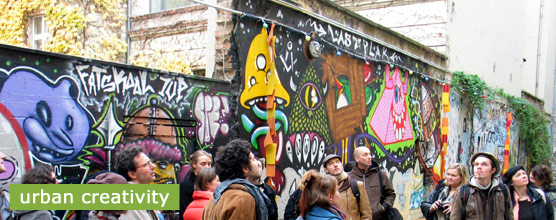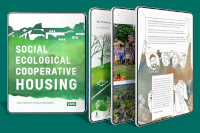Social Ecology
This persepctive argues that questions around climate-change and energy efficiency cannot be solved without first addressing interlinked problems of wasteful consumption, increasing inequality and failing democracy: our current ecological problems stem from deep-rooted social problems.
A growing number of Berlin initiatives including id22 are working with Social Ecology, to critically and practically understand current challenges and opportunities as well as connect local with global issues. Berlin projects and networks are exploring relationships among (human) political-economic structures and (natural) eco-systems. This emerging narrative is founded in a critique of currently dominant practices like speculative, growth-dependent urban development as well as technology-driven and profit-based sustainability agendas. Thus, systemic shifts are called for in both material flows and environmental behaviour, but also in the ways that societies are organized and governed, particularly in cities. Objectives include a comprehensive transformation of society based on understanding synergies among communitarian lifestyles, decentralized and non-hierarchical governance structures, and greater attention to (bio)diversity and environmental justice.
Common Good Orientation
A city with a Common Good orientation emphasizes solidarity, community, democracy and sustainability.
Berlin is pioneering a Common Good approach to housing and urban development, including progressive reorientations of real estate and housing policies. This city is no longer privatizing its property but rather building and acquiring, even considering expropriating housing, working together with city-owned housing companies, cooperatives and non-profit foundations. A Common Good orientation reminds us of the power of the Commons, and calls for ongoing negotiations at the collective and individual levels. This does not lead us to a clear academic, unchangeable definition, but does reflect on local cultures, needs and social patterns. Common Good does not mean that everyone wants the same thing, but rather that the variety of people and cultures making up urban society all need to be involved in decision-making. This involves fair discussions and a redistribution of resources and power. A Common Good urban development is civil-society-based, in cooperation with local government, fairly including all societal groups. In this sense, directly-democratic projects are cooperating with local government and ethical banks and foundations.
CoHousing
Berlin community housing innovations include squats and tent camps, multi-generational, barrier-free and affordable renovations of existing buildings, plus-energy communities, gender-oriented projects, integrative refugee housing, socially inclusive housing and much more.
Berlin stands out internationally for its many hundreds of collaborative housing projects. id22 has been working with this for more than two decades, organizing research, networking, events and publications, to help people understand such housing as well as to increase support for it. Get to know self-organized, community-led housing in Berlin: including cooperatives such as Spreefeld, Forum Kreuzberg and Möckernkiez. These examples and others contribute to an incredible Berlin diversity of community-led, non-profit, common-good, environmental and affordable housing forms serving a sustainable urban development culture. To introduce the variety of Berlin CoHousing cultures, we organize visits to projects, meetings with experts and activists as well as discussions and conferences.
Community Land Trusts
Berlin’s Stadtbodenstiftung, with the assistance of local government as well as id22 and many others including more than 100 donors, has been established as the first German Community Land Trust (CLT), and is a reference for our discussions.
A Community Land Trust (CLT) is a locally-based, democratic, non-profit form of property ownership that withdraws land from speculation, making it permanently available for affordable housing and other social, cultural, environmental or commercial uses. Decisions on the use of CLT land are typically made by an elected advisory board combining the interests of residents and neighbors as well as experts, donors and local government. Uses are thus publicly controllable. Residents and other users, neighbors and supporters help each other to create and maintain a desirable environment with affordable, stable rents. In this way, common good ownership, land and property stewardship, and community empowerment go hand-in-hand. Berlin’s Stadtbodenstiftung works with a variety of cooperative and collaborative housing projects. The CLT model emerged during the US Civil Rights’ Movement of the 1960s and more recently in European cities like London and Brussels.
Kreuzberg – alternative and resistant
“There are always reasons for protest and resistance in Kreuzberg; the actions of the authorities are suspect. Whether office buildings are built or trees are cut down – that’s not for any politician to decide here. In Kreuzberg, the people decide.” (Tagesspiegel, Jan. 5, 2009). This is Kreuzberg.
The last decades
Since the end of the 1960s, the protest culture in the immigrant and working-class district of Kreuzberg has been pronounced. Student revolts took place, and protests were directed against occupational bans, youth unemployment or the oppression of Kurds in Turkey. Starting with left-wing theater groups, these actions were increasingly supported by the local population. A significant expression of the protest culture in Kreuzberg has been around 150 occupations of older buildings that were to be demolished. As early as 1971, the first Berlin squat of the Rauch Haus at Mariannenplatz prevented the demolition of part of the Bethanien Hospital. Many projects like this were legalized and police evicted others after bitter fights. The bourgeois press branded the squatters as rioters. Protests were supported by the “Alternative Liste” (forerunner of the party “Die Grünen“)1 founded in Kreuzberg in 1978, and the newly founded daily newspaper “taz“, which is still based in Kreuzberg today.
Today
As a result of dramatic privatization of property including public housing, the issue of gentrification has increasingly gained attention.
In recent years, resistance has taken on broader forms: The tenants’ association Kotti & Co, has set up a permanent information and protest shelter (Gecekondu) at Kottbusser Tor; a refugee camp at Oranienplatz brought the situation of refugees into the public eye in 2013/14; and the successful protest over the sale of the Dragoner Areal next to the Mehringdamm prevented the site from being privatized.
The initiative Nomadic Green organized a successful campaign collecting over 30,000 signatures in order to save the Moritzplatz Prinzessinnengarten community gardens, created as a model of “urban, neighborhood gardening”.
Edible Landscapes
Berlin has around 150 community gardens: peaceful places of learning and important components of a livable, climate-adapted city.
Berlin is one of the greenest cities in Europe, and so the many urban gardening projects deserve attention. These green oases not only provide a pleasant (micro)climate and recreation, but also bring people of all generations and cultures together. Many examples are to be found in the city center, each one unique in its own way and yet pursuing similar goals: Knowledge transfer and education, promotion of social interaction and greening with mainly edible plants in urban spaces. The Spreefeld neighborhood with Holzmarkt and Teepee Land, is one of these exemplary places: the Spreeacker initiative, founded here in 2012, now maintains well over 100 edible plant species. The now realized participatory co-design of the public Spree riverside path has emerged as a model project, with its edible and productive landspaces.



